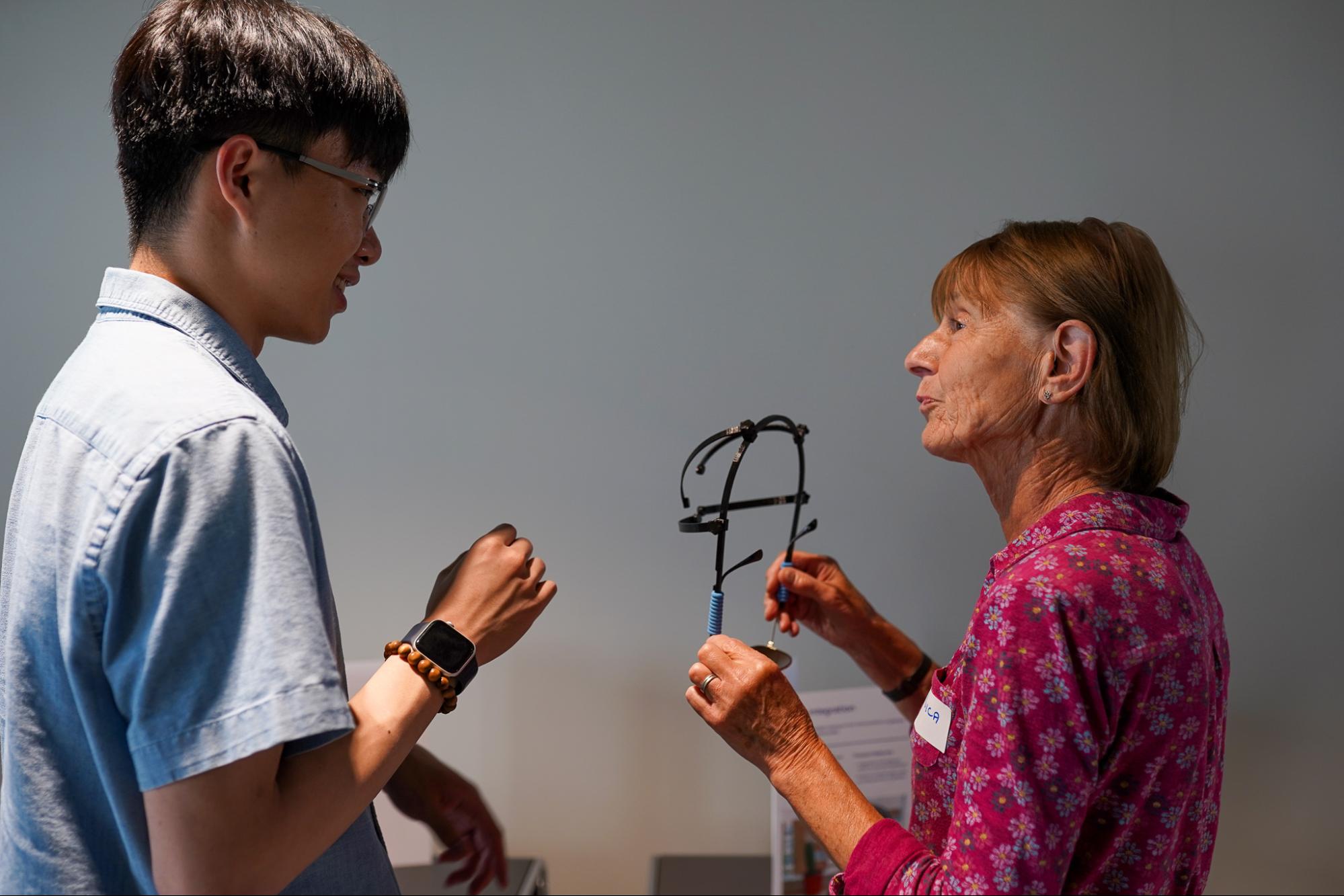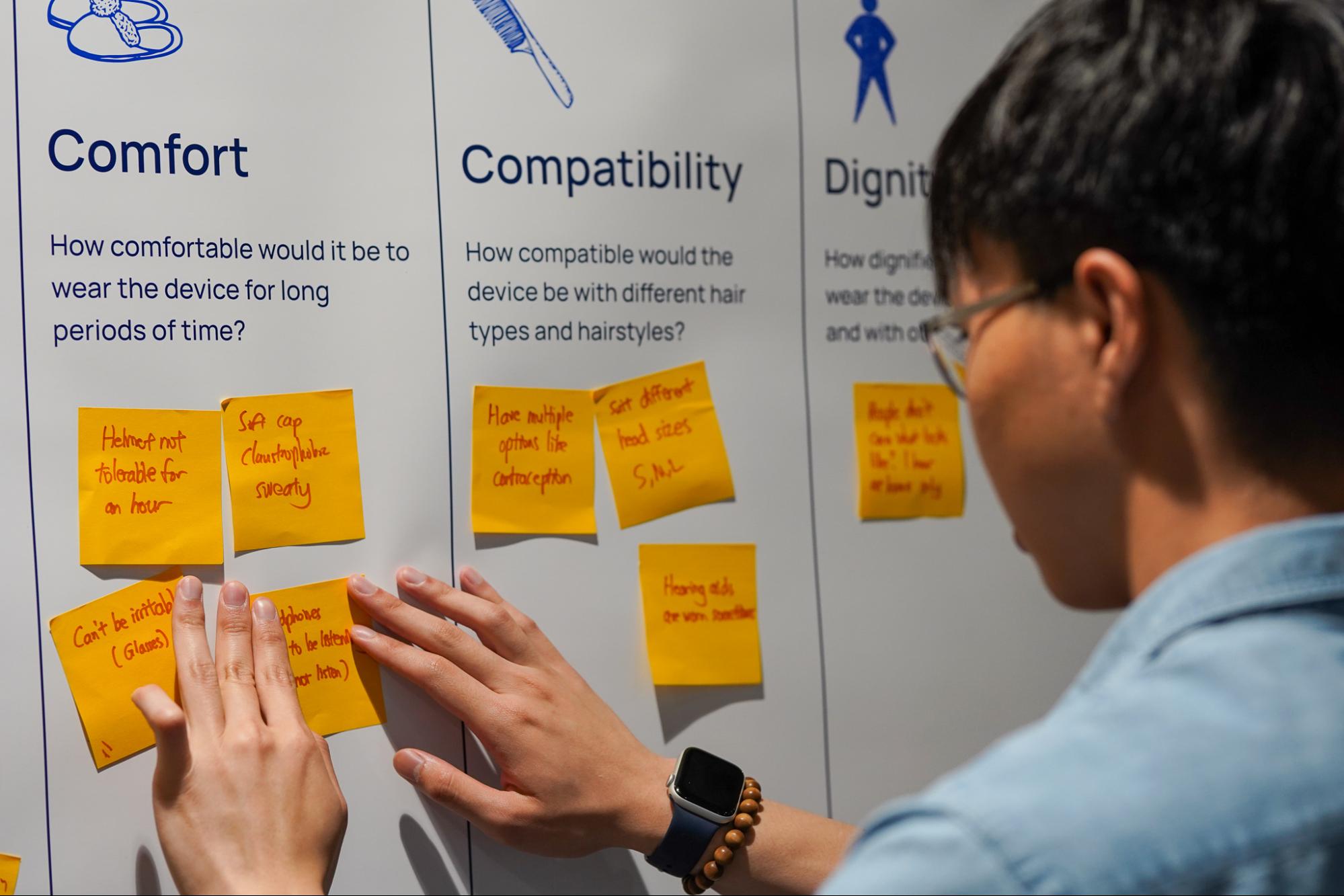
Temporal Interference Brain Stimulation
A Human-centred approach to a new technology
Role:
Helix Centre: Human-Centred Design and PPIE facilitators
Partners:
Nir Grossman’s Research Group (UK DRI at Imperial): Technology leads
Alzheimer’s Society: Charity partner
Introduction
Involving people
The Helix Centre has played a pivotal role involving people affected by dementia, and dementia-related professionals in the early stage development of an innovative new technology being developed by Nir Grossman’s at Imperial College London.
Using human-centred design methods, the Helix Centre have worked with a diverse range of potential end users to understand their views on the technology and integrate these into the technology’s development. This is to ensure that people’s lived experiences remain at the heart of the research process and the resulting technology is acceptable to users; creating the maximum potential impact for people living with dementia and their families. Their endeavours have already led to important changes in the technology design and how it may be used in the future.
Human-centred design approach
Human-centred design (HCD) is an approach to design and innovation that puts the needs of the intended end-user front and centre in determining the direction of technology innovation to create products and services that have an optimum chance of achieving the desired improvement in health outcomes as well as translating into widespread practice.

A user workshop to get feedback on prorotypes
HCD includes patient and public involvement and engagement (PPIE) activities traditionally associated with research. It also goes far beyond this by drawing on end-users' creative ideas as well as experiences, by helping them to envisage their role in the application of the technology.
Innovative technology
Nir Grossman’s Research Group at UK Dementia Research Institute at Imperial College London is developing a stimulation technology that reaches deep brain structures in the expectation that it can provide therapy for people with dementia and other cognitive conditions.
Similar techniques are already used in Parkinson’s Disease treatment but rely on surgical implants. However, Imperial’s innovation is to make the technology non-invasive, using electric fields to stimulate the brain through a headset.
This non-invasive approach makes the therapy more accessible to a wider range of people and including possible use in the home by people with dementia.
Watch a demonstration video to see how the device is currently set up and used:
The technology is still in the early stages of development but has been proven safe for use having already been trialled in healthy humans. Involving people in this very early stage has allowed for people affected by dementia to truly shape how the technology is being developed - creating the greatest opportunity for future potential impact.
Part 1: User and clinical/care team research
User research
A series of in-person and online workshops were held with people who wanted to get involved in the research. Participants were recruited through the Alzheimer’s Society Research Network and from the clinical trial studies being carried out by Nir Grossman’s research group.

A workshop to scope out the human factors for consderation.
The virtual workshops allowed people to take part from the comfort of their own home, while the in-person workshop created an informal safe space where connections could form.
“I have been involved with the Research Network since it’s inception. There has been a huge amount of research but it is disappointing that very little is implemented. If this works and could be implemented to all who could benefit it would be revolutionary.”
Research participant
Clinical and care team research
Online interviews were held with dementia care professionals to understand their view of how the technology would work. A broad range of professionals were interviewed, to gain different perspectives, such as assistive technology specialists, dementia nurse specialists, dementia support workers and neurologists.
“I think we can get so caught up in the technology. You forget about that human side of someone actually coming into your home and having a cup of tea... that's all part of the experience as well”
A dementia support worker discussing the holistic approach needed to be taken when introducing technologies into the homes of patients
The breadth of professional perspectives garnered from this research offered an insight into how important it is to take a holistic approach to designing technology for home use.
"Some people live on canal boats and some people live in mansions"
A home care nurse discussing the need for technologies to be personalised in order to suit the context of patients circumstances
Insights
The insights that people affected by dementia shared are essential for the research team to understand how the technology could be used.
The insights that people shared have already affected the way that the technology is being designed, by now considering home use. This was not previously considered, but through the co-design process was highlighted as an essential feature.
The findings identified can be categorised into five themes:
- Personalisation
Tailoring the technology and its use to the individual. - Acceptability
How acceptable the technology is to people and what influences this. - Support
The support needed by the person living with dementia, their family or carers and dementia care professionals to use the technology. - Meaningful information
What information is most important to share and when to share it? - Terminology
How do we talk about and describe the technology?

A framework developed to map insights from the user workshops
As shown above, each of these five themes sits across all stages of the user journey - from an individual finding out about the technology and deciding to use it, to using it in their own home. Inclusive design is an essential principle of the entire design process.
Outputs
A key output from Part 1 was a written report documenting and highlightighting all our insights from the research process. To request the report, please contact Sophie Horrocks sophie@helixcentre.com.
Part 2: Early-stage prototyping
Developing prototypes
As an extension of the research carried out in Part 1, the Helix Centre translated user insights into 5 early stage prototypes to test initial ideas of potential headset device forms which could be used at home. This research was designed to bring to life the themes and topics discussed in Part 1, by creating physical headset designs which participants could pick up and try on.
5 early-stage prototypes of the headset form were developed from Part 1 insights.

An early prototype for user feedback
Prototypes were developed using a range of rapid prototyping tools, including custom built designs which were 3D printing, as well as “hacking” existing products to create the desired form.
Although prototypes are at the very early stages of development, the benefit of rapid prototyping allows ideas to be tested early and quickly. By utilising these methods, the Helix Centre were able to ground abstract and speculative scenarios into tangible experiences - encouraging deeper insights and discussions to be had around a desired user experience.
Prototyping workshops
To test these early design ideas, we ran two workshops with participants recruited from the Alzhiemer’s Society Research Network and Clinical trials as well as the UK Dementia Research Institute’s Lived Experience Group.

Getting feedback on an early prototype
The online workshop was arranged to ensure that those unable to attend in-person (due to geographical, logistical or access needs) would still be able to participate in the research. We also offered an offline version via forms to ensure those unable to attend both workshops, could still share their feedback.
Insights
Key insights highlighted preferences towards lightweight designs which were adaptable and integrated into existing products. Designs covering the whole head raised issues of claustrophobia and overheating if worn for long periods of time.
Additional insights around safety and accessibility of digital devices and software were highlighted and will be key to addressing in the next stage of development.
There is also a critical need to ensure any future prototypes are tested with a range of different hair types and styles, to ensure that devices are function and suitable for different demographics.

Documenting insights during a workshop
Reflections
Throughout Part 1 and Part 2 research, we have cultivated a strong and passionate group of people affected by dementia who we have worked with to understand the most important factors to consider when designing and developing such a potentially transformative technology.
This strong sense of partnership that has been developed, where people with lived experience are co-creating the technology with us, is crucial to any future technology developed and deployed from this research, being acceptable and usable for future users.
There was a true sense of patient engagement as people with Parkinson’s, multiple sclerosis and carers of people with Alzheimer’s were there with researchers, clinicians and representatives from charitable organisations in round table discussions as part of the collaborative process of co-creation in research.”
Participant , who has Parkinson’s disease speaking about her involvement in the latest workshop
Contact
If you’d like to find out more about this research project, please contact: sophie@helixcentre.com



